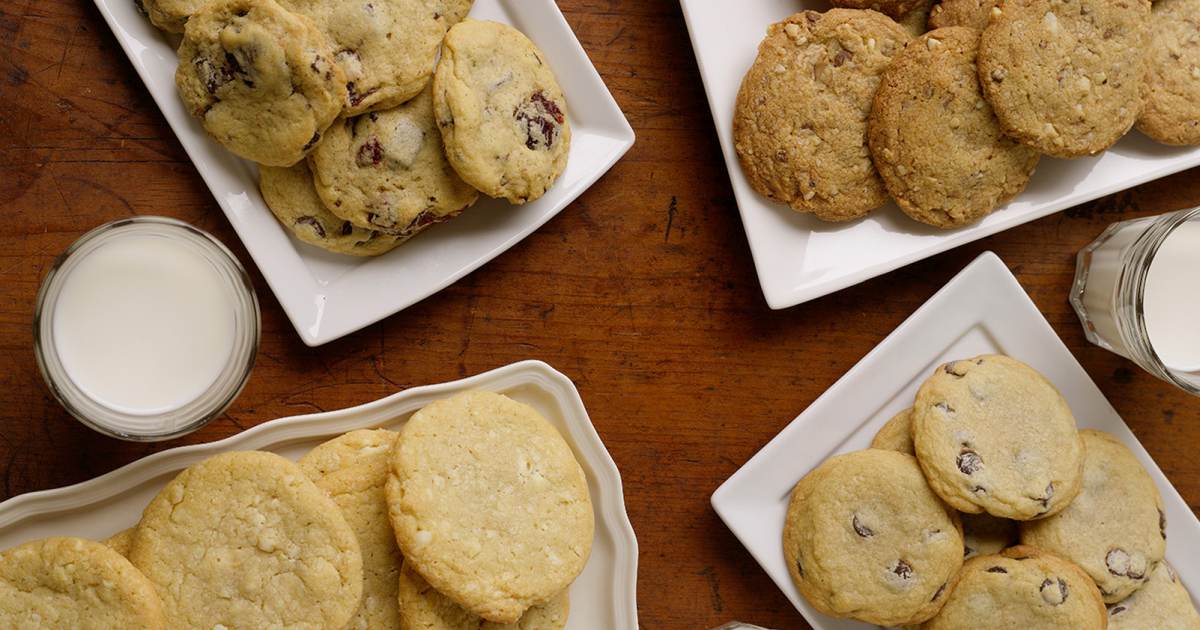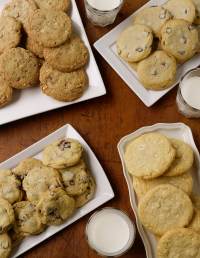
For many of us, eating cookies still warm from the oven is one of our fondest childhood memories. And at this time of year, making, enjoying, and gifting cookies is a treasured holiday tradition. Here’s what you need to know before you whip up your next batch.
It takes all types
The names of many cookie types are derived from the way the cookie dough gets from the bowl onto the baking sheet. Drop cookies are shaped by dropping the dough from a spoon onto a baking sheet, while icebox cookies are shaped into a log and chilled before slicing and baking. The dough for cutout cookies, such as gingerbread and sugar cookies, is rolled out into a thin sheet, and then cut with cookie cutters or a knife.

If a cookie batter is soft enough, you can give it a special shape by making pressed cookies (press the batter through a cookie press) or piped cookies (pipe it through a pastry bag). Bar cookies are made from soft batters that are spread in a pan before baking, then cut into individual cookies once baked. Twice-baked cookies are first shaped into a single, large log-shaped cookie, then baked and sliced. You then bake them a second time for a wonderful crisp texture, perfect for enjoying with coffee or tea.

Very delicate cookies known as tuiles are made by spreading a batter in a thin layer in a stencil on a baking sheet. They bake quickly, and when they’re removed from the oven, they can be rolled, curled, curved, or draped to make edible containers or elegant garnishes.
There’s a method to the mixing
Cookies are made using a variety of mixing techniques. Many cookies are made with the creaming mixing method, which is also used for certain quick breads and cakes. However, the technique varies slightly when applied to cookies rather than muffins: the creaming step is shorter for cookie recipes to keep them from rising too much in the oven. This shorter creaming time also keeps the butter or shortening cooler longer. If the dough becomes too warm as you mix and shape it, the cookies may spread too much and run into each other when they’re baked.
The foam mixing method, used for sponge and angel food cakes, is also used to make some cookies. Whipping eggs and sugar into a thick foam allows you to make a delicate cookie with very little flour. These cookies crumble less than those made by the creaming mixing method and have a delightful resilient texture; fudge brownies and biscotti are two examples of cookies made using this technique.
Baking basics
Not all cookie recipes require you to grease the pan, so read your recipe carefully before you start. When you do need to grease, cooking sprays make it simple to apply a very even but light coating of oil. Or, you can substitute parchment paper or heat-resistant and reusable silicone mats.
Cookie sheets and baking pans should be at room temperature when you grease and fill them; otherwise, the cookie dough might start to bake before it gets in the oven, which results in overspreading and overcooking. If you are baking several batches and don’t want to wait for the sheets to cool down between each one, portion out the remainder of the cookie batter on additional sheets of parchment paper. Then, you can quickly slide the baked cookies off the baking sheet and slide the parchment filled with unbaked cookies onto the sheet and put it right in the oven.
Cool, store, and enjoy
The most important step in storing cookies is to let them cool completely on racks before you put them away. A good cookie jar or tin with a tight-fitting lid keeps plump, cake-like treats like chocolate chunk cookies from becoming stale. If they start to dry out, you can put an apple slice, skin side down, in the cookie jar; take it out after a day or two. Because cookies contain a significant amount of sugar (which attracts moisture from the air), they can turn soggy or stick together. If cookies turn soft, carefully separate them and put them on an ungreased cookie sheet in a warm (300-degree F) oven for about five minutes. Very delicate cookies, such as tuiles, may need to be stored with a cushion of waxed or parchment paper between layers to prevent them from drying and breaking under their own weight.
Once bar cookies are cut into pieces, they keep best if they’re individually wrapped; exposing the cut edges to the air dries them out. If you prefer, leave them uncut until you’re ready to serve them. Most baked cookies freeze well for up to two or three months, wrapped well in plastic or stored in freezer bags or containers with tight lids.
You can also store unbaked cookie dough in the refrigerator or freezer, as long it was made using the creaming mixing method. Form the dough into a log and wrap well. The log should stay fresh in the refrigerator for up to two weeks. For longer storage—up to four months—place it in the freezer. You can then slice the dough when it’s still frozen and transfer it straight to the oven.
With all of these cookie-making tips in your repertoire, you’re ready to bake! Here’s a CIA favorite to try:

Chocolate Cherry Chunk Cookies
Makes about 2 dozen cookies
Ingredients:
½ pound (2 sticks) unsalted butter, soft
2/3 cup granulated sugar
½ cup packed light brown sugar
1 teaspoon salt
2 teaspoons pure vanilla extract
2 large eggs
2½ cups all-purpose flour
2 teaspoons baking soda
1¼ cups dried cherries
3 cups semisweet chocolate chunks or very coarsely chopped semisweet chocolate
Directions:
- Preheat the oven to 350 degrees F. Line a baking sheet with parchment paper.
- In the bowl of a stand mixer fitted with a paddle attachment, gently blend the butter, sugars, salt, and vanilla on low speed until combined, about 2 minutes.
- Gradually add the eggs, scraping down the bowl after each addition.
- In a medium bowl, combine the flour and baking soda and whisk to combine. Add to the egg-butter mixture and mix on low speed just until combined.
- Using a rubber spatula, fold in the cherries and chocolate.
- Scoop about ¼ cup dough onto the prepared baking sheets about 1½ inches apart.
- Bake until golden around the edges but still light in the center, 15 to 18 minutes. Rotate and switch the baking sheets as necessary for even baking.
- Allow the cookies to cool for a minute on the baking sheet then transfer, using a spatula, to a cooling rack and allow to cool completely. Store the cookies in an airtight container.
